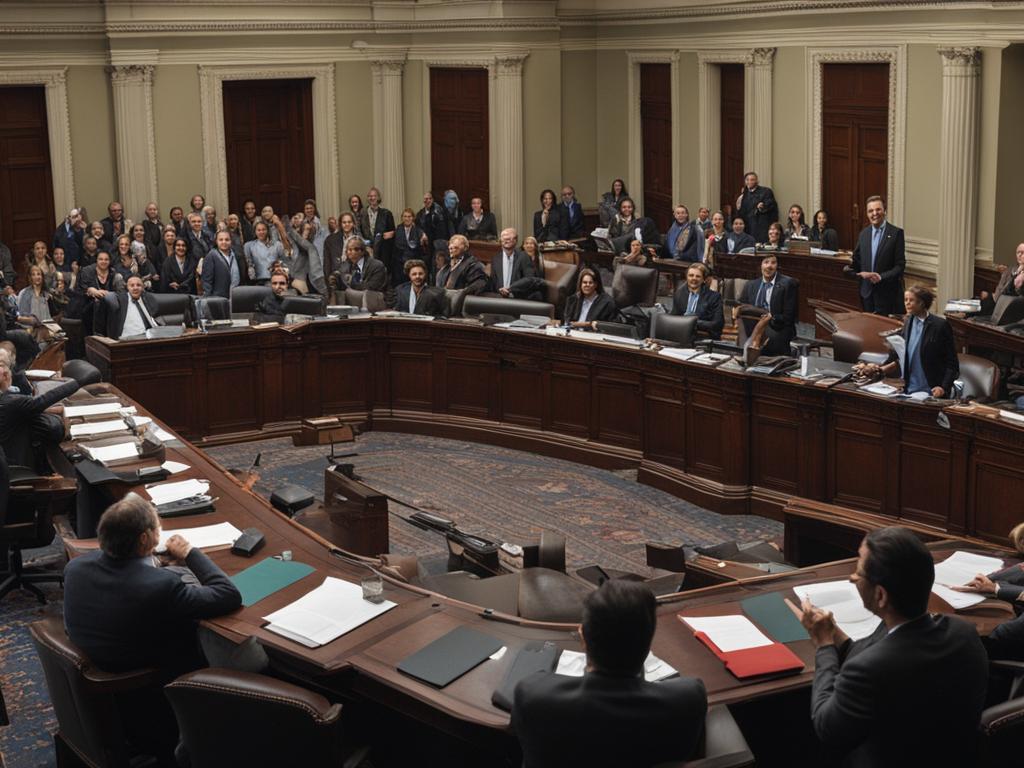Understand Politics: How a Bill Becomes a Law Worksheet
Creating laws is the U.S. House of Representatives’ most important job. All laws in the United States begin as bills. Before a bill can become a law, it must be approved by the U.S. House of Representatives, the U.S. Senate, and the President. Let’s follow a bill’s journey to become law.
Key Takeaways:
- Creating laws is the primary responsibility of the U.S. House of Representatives.
- Laws in the United States start as bills.
- A bill must go through approval from the U.S. House of Representatives, the U.S. Senate, and the President to become law.
- Understanding the process of how a bill becomes a law is crucial for citizens to actively participate in the legislative process.
- Engaging with the legislative process empowers citizens to have a voice in shaping the laws that govern the country.
The Bill Begins
Laws in the United States start as ideas that can come from either a Representative or a citizen. If you have an idea for a law, you can contact your Representative to discuss it. They will then evaluate the idea and potentially turn it into a bill. This is an important part of the legislative process, as it allows citizens to actively participate and contribute to the creation of laws that impact their lives.
Once a bill is proposed, it requires a sponsor in order to move forward. The Representative who wrote the bill will seek support from other Representatives, explaining the purpose and potential benefits of the bill. If enough Representatives show their support, the bill can proceed to the next stage.
The Bill Is Proposed
Once a bill has been written by a Representative, it requires a sponsor to move forward in the legislative process. The Representative must garner support from other Representatives by discussing the bill and its potential impact. It is through these discussions that the Representative hopes to secure the support necessary to introduce the bill.
Introducing a bill is a crucial step in the legislative process. In the U.S. House of Representatives, a bill is officially introduced when it is placed in the hopper. The hopper, a special box on the side of the clerk’s desk, is where bills are submitted for consideration. It is important to note that only Representatives have the authority to introduce bills in the U.S. House of Representatives.
The proposal of a bill marks the beginning of its official journey towards becoming a law. However, before it can proceed further, the bill must navigate through several additional stages, each of which plays a significant role in shaping its final outcome.
| Step | Description |
|---|---|
| 1 | Representative writes the bill. |
| 2 | Bill requires a sponsor. |
| 3 | Representative discusses the bill with other Representatives for support. |
| 4 | Bill is introduced by placing it in the hopper. |
“The proposal of a bill is a critical step in the legislative process, as it sets the stage for further examination and debate. It is through this initial introduction and the support it garners that a bill gains the opportunity to move forward and potentially become a law.” – Political Analyst
The Bill Is Introduced
Once a bill has been written and sponsored, it is ready to be introduced in the U.S. House of Representatives. The process begins with the bill being placed in the hopper, a special box on the side of the clerk’s desk. It is important to note that only Representatives have the authority to introduce bills in the U.S. House of Representatives.
The introduction of a bill is a significant step in the legislative process. It marks the official entry of the bill into the House of Representatives and signals that it is ready to be considered and debated by the Representatives. By introducing a bill, the sponsoring Representative is expressing their commitment to advocating for the proposed legislation.
Introducing a bill is just the start of its journey towards becoming a law. From here, the bill will proceed to committee for further review, research, and revisions. The committee members, who are experts in relevant fields, will thoroughly examine the bill before deciding whether to send it back to the House floor for debate and voting. The introduction of the bill lays the foundation for these subsequent stages in the legislative process.

Summary:
- The bill is introduced in the U.S. House of Representatives.
- Only Representatives have the authority to introduce bills.
- The introduction of a bill marks its official entry into the legislative process.
- After being introduced, the bill proceeds to committee for further review and revisions.
- The introduction of a bill is a crucial step towards its potential enactment as law.
The Bill Goes to Committee
After a bill is introduced in the U.S. House of Representatives, it moves to the next stage in the legislative process: committee review. Committees play a crucial role in shaping and refining bills before they are voted on by the House. These committees consist of groups of Representatives who have expertise in specific areas such as agriculture, education, or international relations. Their task is to carefully review, research, and revise the bill to ensure its effectiveness and alignment with the committee’s area of focus.
The committee review process involves in-depth discussions and analysis of the bill’s content. Committee members thoroughly examine the proposed legislation, scrutinizing its provisions and considering potential improvements or modifications. This comprehensive assessment helps to refine the bill, ensuring that it addresses the specific issues it aims to resolve. It also allows committee members to identify any potential conflicts or contradictions with existing laws or regulations.
During committee review, there may be amendments proposed to the bill. These amendments can be significant changes or minor adjustments to specific sections. Committee members engage in debates and negotiations to determine the most appropriate amendments to incorporate into the bill. The goal is to fine-tune the legislation to enhance its effectiveness and increase the likelihood of it being supported by a majority of Representatives.
Committee Voting and Report
Once the committee members have thoroughly reviewed the bill and reached a consensus, a voting process takes place. Committee voting determines whether the bill will move forward in the legislative process or be rejected. This vote is typically based on the committee members’ analysis, discussions, and amendments made during the review process.
If the majority of the committee members vote in favor of the bill, it is reported back to the House floor. The committee prepares a report summarizing the bill, the amendments made, and the committee’s recommendations. This report provides valuable insights to the other Representatives who will ultimately vote on the bill. It helps them understand the committee’s rationale behind the proposed legislation and the changes made during the review process.
| Committee Review Stage | Actions |
|---|---|
| Thorough examination of the bill | Committee members review the bill, analyze its provisions, and identify potential improvements. |
| Amendments | Committee members propose and discuss amendments to refine the bill. |
| Voting | The committee votes on whether to move the bill forward or reject it. |
| Report | If the bill is approved, the committee prepares a report summarizing the bill, amendments, and recommendations. |
Understanding the Lawmaking Process Worksheet
Once a bill has been approved by the committee, it is reported to the House floor for debate in the U.S. House of Representatives. This is a crucial step in the lawmaking process as it allows Representatives to discuss the bill and express their agreement or disagreement with it. During the debate, a reading clerk reads the bill section by section, and Representatives have the opportunity to suggest changes.
Debates on bills can be lively and passionate, with Representatives providing arguments and explanations for their stance on the bill. This open discussion allows for a thorough examination of the proposed legislation and ensures that all perspectives are heard. It is during this stage that amendments may be proposed and considered.
Once all changes and amendments have been made, the bill is deemed ready to be voted on by the U.S. House of Representatives. The voting process can take different forms, including Viva Voce (voice vote), Division (stand up and be counted), or Recorded (using the electronic voting system). If a majority of Representatives vote in favor of the bill, it passes in the U.S. House of Representatives and moves forward in the lawmaking process.

It is important to note that this is just one part of the overall lawmaking process, and the bill will still need to go through similar steps in the U.S. Senate before it can become a law. Understanding the lawmaking process allows citizens to actively engage with their elected representatives and participate in shaping the laws that govern our society.
The Bill Is Debated
When a bill is debated, Representatives engage in a thorough discussion to express their views and arguments for or against the bill. This stage allows for a comprehensive analysis of the proposed legislation, enabling Representatives to provide their input and shape the bill further. During the debate, the Representatives may reference relevant data, statistics, or anecdotes to support their positions and influence the outcome of the bill.
Representatives take turns addressing the House, voicing their opinions and concerns. The Speaker of the House maintains order and ensures that the debate remains respectful and focused on the topic at hand. The bill is carefully scrutinized, with each section being read aloud by the reading clerk. This process allows for a detailed examination of the bill’s content, facilitating discussions on potential amendments and revisions.
“The power of meaningful debate lies in its ability to reveal the strengths and weaknesses of a bill. It is through these discussions that we explore the potential impacts and consequences of proposed legislation, paving the way for informed decision-making. The value of open and robust debate cannot be overstated in the legislative process.”
Once all changes, additions, and deletions have been proposed and considered, the bill is deemed ready for a vote. The deliberative process ensures that the bill’s language reflects the collective input and expertise of the Representatives. This stage showcases the diversity of perspectives within the House and exemplifies the democratic principles upon which our legislative system is built.

Debate Highlights
During the debate on a bill, several key elements play a significant role:
- Affirming Support: Representatives express their agreement with the bill, highlighting its merits and positive impact.
- Raising Concerns: Some Representatives voice their opposition or skepticism, pointing out potential flaws or unintended consequences.
- Suggesting Amendments: Amendments may be proposed to modify certain provisions of the bill, addressing concerns or improving its effectiveness.
- Responding to Questions: Representatives may ask questions to clarify certain aspects of the bill or challenge the arguments put forth by their colleagues.
Through this process, the bill undergoes intense scrutiny and evaluation, ensuring that it reflects the diverse viewpoints and interests of the Representatives.
| Key Points | Impact |
|---|---|
| Open and robust debate | Enables thorough examination of the bill |
| Collective input and expertise | Leads to informed decision-making |
| Amendments proposed and considered | Enhances the bill’s effectiveness |
The Bill Is Voted On
Once the bill has gone through the process of being debated, it is time for the representatives to vote on it. There are three methods for voting on a bill in the U.S. House of Representatives: Viva Voce (voice vote), Division (stand up and be counted), or Recorded (using the electronic voting system). Each method allows the representatives to express their opinion on the bill and determine its fate in the House.
During a Viva Voce vote, the Speaker of the House will ask for those in favor of the bill to say “aye” and those opposed to say “no.” The Speaker then decides which side has the majority. In a Division vote, representatives physically stand up and are counted as being in favor or against the bill. Finally, during a Recorded vote, the representatives use the electronic voting system to cast their vote either in favor or against the bill.
If a majority of the representatives say or select yes, the bill passes in the U.S. House of Representatives. The bill is then certified by the Clerk of the House and delivered to the U.S. Senate for further consideration. It is important to note that each representative’s vote carries equal weight, regardless of their position or seniority. This ensures a fair and democratic process in determining the fate of the bill.

Conclusion
When a bill reaches the U.S. Senate, it goes through similar steps as it did in the U.S. House of Representatives. If the bill passes in both the House and Senate, it is sent to the President. The President can sign and pass the bill, refuse to sign or veto the bill (which may be overridden by Congress), or do nothing (pocket veto). If a bill becomes a law, it is enforced by the government.
Understanding the legislative process is crucial for citizens to actively participate in and engage with the lawmaking process. By having a clear grasp of how a bill becomes a law, individuals can effectively voice their concerns and opinions to their Representatives and Senators. It empowers citizens to advocate for changes they believe in and helps shape the future of the country.
To enhance your understanding of the legislative process, you can use a legislative process worksheet. This resource provides a step-by-step overview of how bills progress through the House of Representatives and the Senate. It highlights the key stages, such as bill introduction, committee review, debate, voting, and presidential approval. By using this worksheet, you can further consolidate your knowledge and actively engage in the democratic process.
FAQ
How does a bill become a law in the United States?
A bill becomes a law in the United States by being approved by the U.S. House of Representatives, the U.S. Senate, and the President.
Where do laws in the United States begin?
All laws in the United States begin as bills.
Can anyone propose a bill?
Yes, both Representatives and citizens can propose bills.
What is the first step in the process of a bill becoming a law?
The first step is for a Representative to write a bill and find a sponsor for it.
How is a bill introduced in the U.S. House of Representatives?
A bill is introduced in the U.S. House of Representatives by being placed in the hopper, a special box on the side of the clerk’s desk.
Who reviews and revises the bill before it is sent back to the House floor?
Committee members, who are groups of Representatives with expertise in different topics, review and revise the bill.
How is a bill debated in the U.S. House of Representatives?
Representatives discuss the bill, explain their positions, and recommend changes. A reading clerk reads the bill section by section.
How is a bill voted on in the U.S. House of Representatives?
There are three methods of voting: Viva Voce (voice vote), Division (stand up and be counted), or Recorded (using the electronic voting system).
What happens if a bill passes in both the U.S. House of Representatives and the U.S. Senate?
If a bill passes in both chambers, it is sent to the President for approval.
What can the President do when a bill is sent to them?
The President can sign and pass the bill, refuse to sign or veto the bill (which may be overridden by Congress), or do nothing (pocket veto).
How is a bill enforced as law?
Once a bill becomes a law, it is enforced by the government.

